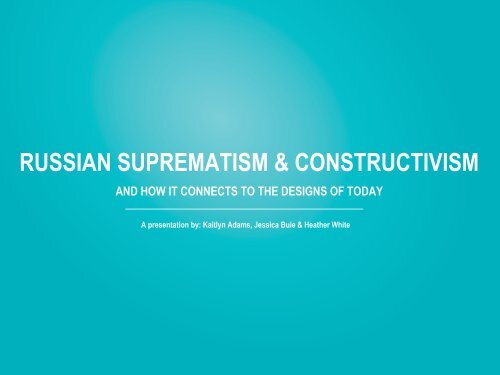Russian suprematism and conservatism - Graphic Design History
Russian suprematism and conservatism - Graphic Design History
Russian suprematism and conservatism - Graphic Design History
You also want an ePaper? Increase the reach of your titles
YUMPU automatically turns print PDFs into web optimized ePapers that Google loves.
RUSSIAN SUPREMATISM & CONSTRUCTIVISM<br />
AND HOW IT CONNECTS TO THE DESIGNS OF TODAY<br />
A presentation by: Kaitlyn Adams, Jessica Buie & Heather White
RUSSIAN SUPREMATISM & CONSTRUCTIVISM: CONTEXT<br />
Context
RUSSIAN SUPREMATISM & CONSTRUCTIVISM: CONTEXT
RUSSIAN SUPREMATISM & CONSTRUCTIVISM: CONTEXT<br />
Piccasso, Still Life with Chair Caning, 1912
RUSSIAN SUPREMATISM & CONSTRUCTIVISM: CONTEXT<br />
Duchamp, Nude Descending a Staircase, 1912<br />
Boccioni, Unique Forms of Continuity in<br />
Space, 1913
RUSSIAN SUPREMATISM & CONSTRUCTIVISM: CONTEXT<br />
Suprematism<br />
Years of influence: 1915 - late 1930s<br />
Earliest <strong>and</strong> most radical development in abstract art<br />
Name came from Malevich's belief that "Suprematist art would be superior to all the art of the past".<br />
Malevich believed "there were only delicate links between words or signs <strong>and</strong> the objects they denote,<br />
<strong>and</strong> from this he saw the possibilities for a totally abstract art".<br />
Intrigued by the search for art's barest essentials<br />
Important in shaping Constructivism, influences abstract art today<br />
Interest in abstraction "fired by a search for the 'zero degree' of painting, the point beyond which the<br />
medium could not go without ceasing to be art<br />
Strong tone of absurdism running through the movement
RUSSIAN SUPREMATISM & CONSTRUCTIVISM: CONTEXT
RUSSIAN SUPREMATISM & CONSTRUCTIVISM: CONTEXT<br />
Constructivism<br />
Years of influence: 1915 - late 1930s<br />
Last <strong>and</strong> most influential modern art movement to flourish in Russia in 20th century<br />
Borrowed ideas from Cubism, Suprematism, <strong>and</strong> Futurism<br />
Sought to "abolish the traditional artistic concern with composition <strong>and</strong> replace it with 'construction'".<br />
Hoped that its investigation would eventually yield ideas that could be put into mass production,<br />
"serving the ends of a modern, Communist society."<br />
The form an artwork would take "would be dictated by its materials"<br />
Desire to "express the experience of modern life," which included it's "new <strong>and</strong> disorienting qualities of<br />
space <strong>and</strong> time"
RUSSIAN SUPREMATISM & CONSTRUCTIVISM: CONTEXT
RUSSIAN SUPREMATISM & CONSTRUCTIVISM: PEOPLE<br />
People
RUSSIAN SUPREMATISM & CONSTRUCTIVISM: PEOPLE<br />
Suprematism<br />
Influential artists include:<br />
Kazimir Malevich<br />
Ilya Chashnik<br />
El Lissitzky<br />
Alex<strong>and</strong>er Rodchenko<br />
Olga Rozanova<br />
Nikolai Suetin<br />
Vera Yermolayeva<br />
Olga Rozenova<br />
Ilya Chashnik<br />
Vera Yermolayeva<br />
Kazimir Malevich<br />
Alex<strong>and</strong>er Rodchenko<br />
El Lissitzky<br />
Nikolai Suetin
RUSSIAN SUPREMATISM & CONSTRUCTIVISM: PEOPLE<br />
Constructivism<br />
Influential artists include:<br />
Vladimir Tatlin<br />
El Lissitzky<br />
Laszlo Moholy-Nagy<br />
Alex<strong>and</strong>er Rodchenko<br />
Naum Gabo<br />
Lyubov Popova<br />
Varvara Stepanova<br />
Vladimir Tatlin<br />
Laszlo Moholy-Nagy<br />
Varvara Stepanova<br />
El Lissitzky<br />
Alex<strong>and</strong>er Rodchenko<br />
Naum Gabo<br />
Lyubov Popova
RUSSIAN SUPREMATISM & CONSTRUCTIVISM<br />
Technology
RUSSIAN SUPREMATISM & CONSTRUCTIVISM: TECHNOLOGY<br />
Suprematism<br />
Main medium was paint on canvas. The Suprematists' interest in abstraction was fired by a search for the 'zero<br />
degree' of painting, the point beyond which the medium could not go without ceasing to be art. This encouraged<br />
the use of very simple motifs, since they best articulated the shape <strong>and</strong> flat surface of the canvases on which they<br />
were painted. Ultimately, the square, circle, <strong>and</strong> cross became the group's favorite motifs. It also encouraged many<br />
Suprematists to emphasize the surface texture of the paint on canvas. this texture being another essential quality<br />
of the medium of painting.
RUSSIAN SUPREMATISM & CONSTRUCTIVISM: TECHNOLOGY<br />
Constructivism<br />
Constructivist art often aimed to demonstrate how materials behaved - to ask, for instance, what different<br />
properties had materials such as wood, glass, <strong>and</strong> metal. The form an artwork would take would be dictated by its<br />
materials (not the other way around, as is the case in traditional art forms, in which the artist 'transforms' base<br />
materials into something very different <strong>and</strong> beautiful). For some, these inquiries were a means to an end, the goal<br />
being the translation of ideas <strong>and</strong> designs into mass production; for others it was an end in itself, a new <strong>and</strong><br />
archetypal modern style expressing the dynamism of modern life.
RUSSIAN SUPREMATISM & CONSTRUCTIVISM<br />
Contemporary <strong>Design</strong>
RUSSIAN SUPREMATISM & CONSTRUCTIVISM: TECHNOLOGY<br />
Suprematism<br />
Suprematism is highly influential to modern day abstract art. This is clear if you look at K<strong>and</strong>insky's paintings <strong>and</strong><br />
his concept behind them. K<strong>and</strong>insky has a series of paintings that are each a reaction to a particular classical<br />
song. He takes sound <strong>and</strong> transforms it into color <strong>and</strong> shape <strong>and</strong> gives it a physical look that it was lacking<br />
previously.<br />
K<strong>and</strong>insky - abstract art<br />
Suprematism
RUSSIAN SUPREMATISM & CONSTRUCTIVISM: TECHNOLOGY<br />
Constructivism<br />
Constructivism has had a very large impact on Bauhaus <strong>and</strong> De Stijl "The Style" (also known as neoplasticism)<br />
movements. Bauhaus, like Constructivism, was a movement that grew beyond the canvas into architecture. De Stijl<br />
is best recognized by the "tetris" paintings of the primary squares. All three are very minimalistic movements that<br />
focus more on functionality <strong>and</strong> simplicity than extravagance.<br />
Bauhaus<br />
Bauhaus<br />
De Stijl
RUSSIAN SUPREMATISM & CONSTRUCTIVISM: TECHNOLOGY<br />
BIBLIOGRAPHY<br />
Ng, Tracee. "Constructivism."Constructivism Movement, Artists <strong>and</strong> Major Works. The Art Story Foundation, 2012.<br />
Web. 04 Oct. 2012. .<br />
Ng, Tracee. "Suprematism."Suprematism Movement, Artists <strong>and</strong> Major Works. The Art Story Foundation, 2012.<br />
Web. 04 Oct. 2012. .


